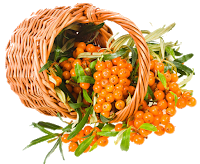What Is Sea Buckthorn & What Are Its Uses?
Posted by Yolanda Campbell on Jun 29, 2018

One ingredient of the oil, palmitoleic acid is an element of skin. The only other major plant source of palmitoleic acid is the macadamia nut. Sea buckthorn has natural sunblock potential, promotes regeneration of tissue, promotes healing of burns, scalds, ulcerations, and infections (Dharmananda, Ph.D.) (Zeb). Used in the cosmetic industry, Sea-buckthorn exhibits anti-ageing and anti-wrinkle properties, as it is a great antioxidant. It firms and tones sagging skin smoothing out wrinkles, increases luminosity, hydration and elasticity (Yang et al.) (Zielińska and Nowak).
Sea buckthorn oil is effective in the care of dry, irritated, rough, flaking and itchy skin. It has also exhibited effective results when used as an auxiliary product in the treatment of frostbites and skin damage resulting from exposure to UV radiation, x-rays and chemical compounds. Sea-buckthorn oil encourages wound healing by stimulating the regeneration and formation of new healthy epidermis, and collagen synthesis (Zielińska and Nowak).
The oil contains an abundance of active substances that are unique in known vegetable oils. Scientific reports confirm the content of almost 200 ingredients that ensure the oil has a multidirectional effect. It is not unreasonable to consider sea-buckthorn oil to be one of the most valuable natural products in the world. The food, medical, pharmacological and cosmetic industries all recognize the beneficial effects of various active ingredients contained in Sea buckthorn oil; utilizing the oil in skin care preparations, like our Songline Body Silk, or as an adjunctive treatment in various diseases. As a natural substance that displays many unique properties, even a small amount added to a product will increase the products effectiveness and uniqueness (Zielińska and Nowak).
References:
Dharmananda, Ph.D., Subhuti. "Sea Buckthorn.” Itmonline.org.
(Dharmananda, Ph.D.)
http://www.itmonline.org/arts/seabuckthorn.htm
Patel, Chirag A. et al. “Remedial Prospective of Hippophae Rhamnoides Linn. (Sea Buckthorn).” ISRN Pharmacology 2012 (2012): 436857. PMC..
https://www.ncbi.nlm.nih.gov/pmc/articles/PMC3317027/
“Sea Buckthorn.” Merriam-Webster.com, Merriam-Webster, www.merriam-webster.com/dictionary/sea buckthorn.
Yang, Baoru et al. Naturalingredient.org. N.p., 2008.
(Yang et al.)
https://www.ncbi.nlm.nih.gov/pmc/articles/PMC5438513/
Zeb, Alam. "Important Therapeutic Uses Of Sea Buckthorn (Hippophae): A Review." Pdfs.semanticscholar.org. N.p., 2004.
(Zeb)
https://pdfs.semanticscholar.org/d9fd/58dfc899dd20974bbb148062a40594d063c4.pdf
Zielińska, Aleksandra, and Izabela Nowak. “Abundance of Active Ingredients in Sea-Buckthorn Oil.” Lipids in Health and Disease 16 (2017): 95. PMC..

